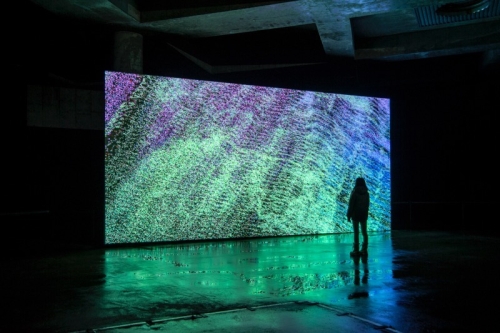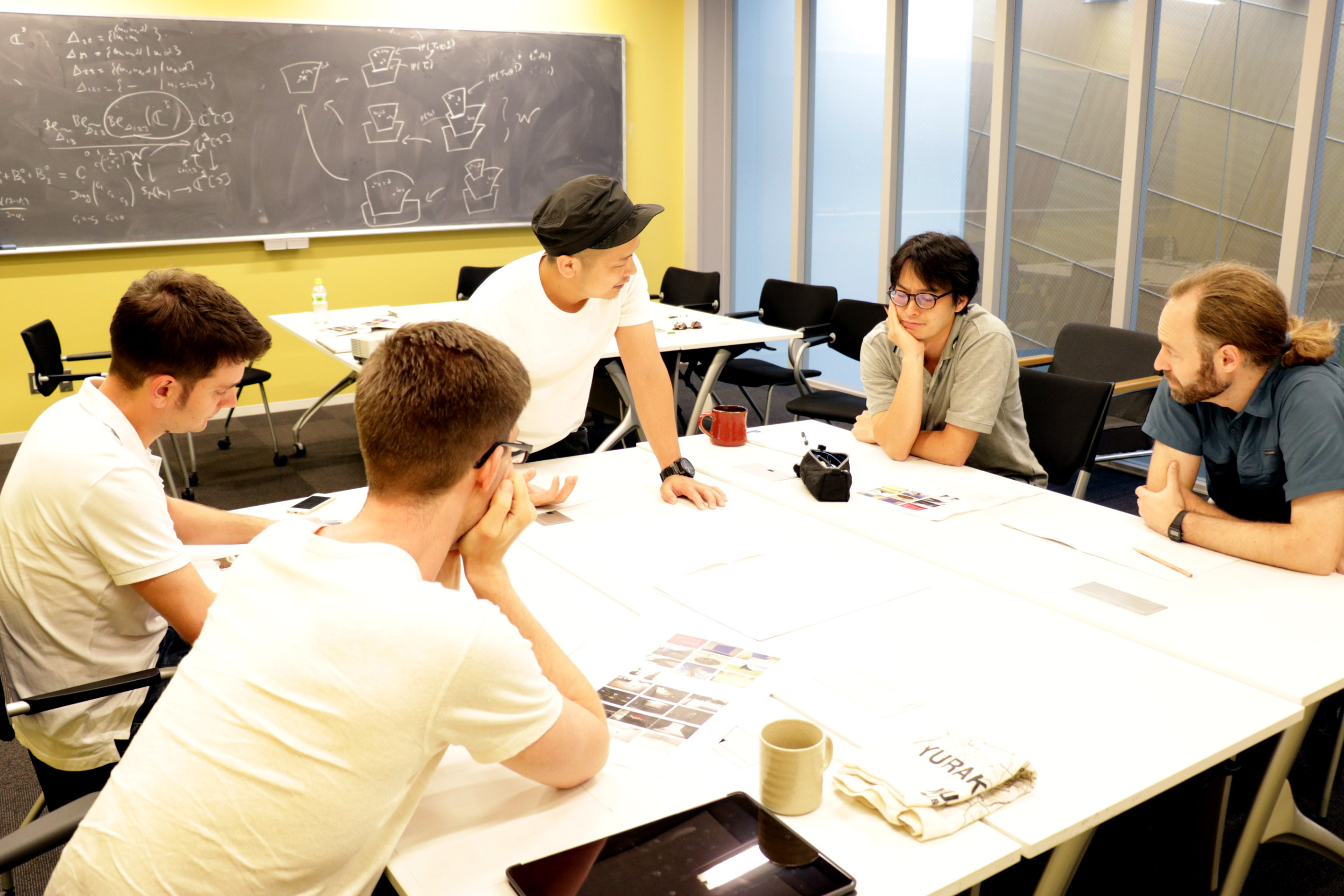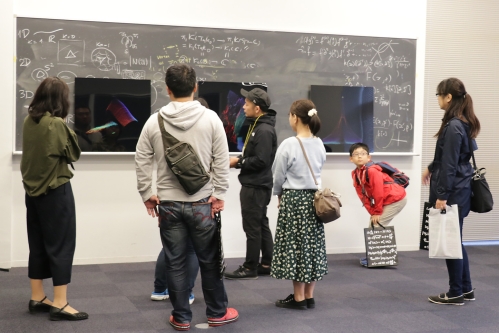Science Institute's Artist in Residence Program Results Showcased in Japan and Overseas: The Artist's View

Date of activity: June 16, 2016 - July 13, 2017
The Kavli Institute for the Physics and Mathematics of the Universe (Kavli IPMU) has hosted an Artist in Residence program since 2015. The program encourages artists to create artworks while staying for a period of time at the Institute, and to publish them as outcomes of their stay, which is marked by mutual exchanges between artists and researchers. One of the objectives of the residence is for both parties to inspire each other.
In the summer of 2016, Norimichi Hirakawa was an artist in residence at Kavli IPMU. While working on his ideas, Hirakawa participated in the Institute’s daily Tea Time routine, where he was able to meet and talk with researchers and explain his ideas. He also hosted a workshop where researchers could experience artistic methods, and invited them into his workplace to show how he creates his works.
A researcher who joined the workshop commented: “Sometimes it is good to do something other than research. I usually work using computer programming languages, so it is interesting to be able to create artworks instead.”
Hirakawa said: “Basically, I’d like to see what I have never seen. For that purpose, making artworks based on the imagination of artists doesn’t make sense anymore. I believe that trying to understand the world using computer programs will give me new insights.”
Thus, Hirakawa makes large-scale artworks such as video with sound installations created through computer programming, and these have been exhibited domestically and overseas for a couple of years. Indeed, the residence prepared him to experiment with entirely new works for future exhibitions in the next few years.
“Fundamental research is conducted at Kavli IPMU. Such an environment has led me to think that while I was only able to think of tangible things initially, the researchers were able to think from the point of view of the unseen,” Hirakawa said.
During his stay, Hirakawa was especially struck by the mathematical idea of high dimensional space. Which is to say, for most people, objects are concrete entities that make up the space of our daily living space—including vertical and horizontal planes and height. But when researchers deal with mathematical objects, dimension means simply the number of elements (number of values).
Hirakawa thought: “If I take photographs of everyday life and deal with them just like mathematical objects, it might bring up some hints about the yet unseen world.”
In practice, this means a picture can be thought of as a set of pixels. A pixel will have both vertical and horizontal positional information and information for color that is separated into RGB (Red, Green, Blue), together giving 5 numbers.
If the dimension is merely a sum of numbers, it is possible to plot all the pixels making up one picture in higher dimensional space—a “5-dimensional Euclidean space” in which these five elements are regarded as coordinates on a point cloud.
“When a researcher heard my idea, his reply was quick: ‘It can be done.’ For everyone else, talk of higher dimensions sounds odd, but for researchers it is part of their everyday life; for me, the difference between how researchers and ordinary folk see the world is interesting,” Hirakawa explained.
Hirakawa speculated about what to calculate that would lead to new insights for his artworks. He finally chose “beauty” as his theme. As an example that may be recognized as “beauty” universally, he transformed the information of the image of a sunset into a higher dimensional space.
The result is not indistinguishable from the original image of the sunset. He thought if a viewer could make sense of it, they could be said to appreciate universal “beauty.”
As one of the results of his residence, Hirakawa exhibited three digital prints and a demonstrational video at the University’s Kashiwa Campus during its Open Days event from October 21 to 22 of last year.
Three digital prints that were created through the application of computer programs to hundreds of photographs of sunsets in order to abstract their essence were mounted on aluminum plates. The demonstrational video, meanwhile, showed a sample application to an image via a computer program that he created.
Some 2,800 people visited Kavli IPMU and experienced the exhibition, where Hirakawa was able to explain his activity. Visitors enjoyed his artworks a lot, especially their “beauty” and “collaboration with science.”
“I want to continue challenging myself because I’ve yet to fully understand the computer program I made, including its behavior and calculation functions,” Hirakawa, who has been developing the idea beyond his residence period, said.
In October last year, as another result of his residence, an audiovisual installation artwork was exhibited at the Toyoda City Art Museum.
On this occasion, in addition to the 5 elements providing information for position and color, information for time was provided as a 6th element. Entire pixels of continuous photos of a sunset were plotted along 6-dimensional Euclidean space and rotated into an animation.
In February 2017, an extension of Hirakawa’s creations, an audiovisual installation, was exhibited at a pre-opening event of the Sapporo International Arts Festival. Hirakawa commented: “After I left Kavli IPMU, I felt that I could take even greater strides.”
He used everyday landscapes rather than sunsets as his motif, and having reconsidered the composition of the animation and the production of its sound, Hirakawa said, “For this time, the true nature of nature seems to have seeped out in a form that differs from the actual one.”
At the exhibition’s closing, Hirakawa added: “Finally, I came to the realization that the data of shapes, the color gradation of the images, and the movement in the time axis were being interchanged. It’s good to know that through creating “datum”.
“This summer,” he continued, “I will participate in a program using a scientific balloon to collect various kinds of environmental data. I aim to use the data in a similar manner [as with the ‘datum’ work]—approaching it from a ‘higher dimension.’”
“The fact that there are many ways to visualize data means that the data itself naturally has no inherent visual representations. I’d like to think about whether it is—or it is not—possible to perceive of abstract high dimensional data as it is,” he added.
In this era, artworks that are said to combine art and science often simply visualize scientific facts or in truth they combine design and new technology. Within the arts, there is a tendency to pursue the contact between art and society, including “relational art,” “socially engaged art,” or to expand the concept of art. Meanwhile, subjects such as reality and metaphysics are being reconsidered within philosophy.
We might say that the “datum” series was an attempt to explore knowledge intrinsic to art via mathematical methods—but also as an alternative to the usual methods of sciences like mathematics or physics—while questioning concepts like beauty and nature itself.
Until June 4, a solo show by him, including “datum,” will be held in Poland. From April 21 to July 13, another group show, titled "DATA CITY" and including "datum," will be held in France.
Links:
- knowns, unknowns and the (ir)reversible – Norimichi Hirakawa, WRO Art Center, Poland, Untill June 4
- DATA CITY, Centre des arts, France, April 21- July 13
- Norimichi Hirakawa

Hirakawa’s audiovisual installation at the Sapporo International Art Festival 2017 (Photo provided by Norimichi Hirakawa) 
Hirakawa invited researchers to his workshop, “A Game or a Thought Experiment: Make an Installation Art Piece from Your Point of View” 
Hirakawa and visitors in front of his exhibition during the Open Days event at the Kashiwa Campus






